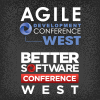Agile Development Conference & Better Software Conference West 2012

PRESENTATIONS
|
Application Lifecycle Management Imperatives
Ever growing software development needs and faster delivery cycles coupled with flat or shrinking IT budgets have brought many organizations to new agile and lean practices. Together, these disruptions are causing a sea of change in the application lifecycle management (ALM) landscape. Although management tools aren’t an explicit focus for most development teams, choosing the right tools for enterprise development is an important factor in keeping everyone productive. |
|
|
Automate to Accelerate: Planning Your Next Test Automation Steps
Is your organization implementing test automation and not achieving the expected success? Are you spending too much effort rewriting scripts that don't hold up over time? Do your test plans sometimes look like random acts of automation? Roi Carmel shares a pragmatic process he’s used for defining automation goals, addressing automation challenges, and assessing an organization’s readiness for automation. |
|
|
Better Software Conference West 2012: Writing High Quality Code
Quality in delivered software is very different from quality in physical goods. You can see it or touch it, except in the code. When classes and methods are cohesive, non-redundant, well-encapsulated, assertive, and explicitly coupled, they are less prone to developer mistakes and far easier to debug, test, and maintain. David Bernstein asserts that paying attention to code quality helps developers focus every day on the key principles, patterns, and practices expert developers use. |
David Bernstein, To Be Agile |
|
Cloud Computing 101: Concepts, Benefits, Challenges, and Costs
Cloud computing is a paradigm that makes the notion of utility computing a reality. Instead of investing scarce capital in computing resources, IT organizations are turning to pay-for-use hardware, software, and infrastructure available through the Internet. Unfortunately, because cloud services vendors have their marketing engines further into the cloud than their technology actually reaches, there is a great deal of hype around cloud computing. |
|
|
Collaboration Workshops: Discover, Plan, and Prepare the Product Backlog
To deliver high-value products, your agile team must reach a shared understanding of prioritized stakeholder needs. Collaborative techniques are best for this type of work, but not all agile teams use them or use them efficiently. Some rely too heavily on written user stories or story maps and fail to address complex topics or resolve requirements conflicts among stakeholders. |

Ellen Gottesdiener, EBG Consulting, Inc. |
|
Context-driven Leadership: How to Ride a Bull through a China Shop
Software development projects are just different. They’re often high-risk ventures with extremely complex interrelationships, filled with uncertainties, dependent on scarce knowledge workers, and much more. So, the leadership style and skills needed to be successful are quite different from those needed in simple, stable projects that run through organizations. |
|
|
Creating a Professional Credo: Aligning Career, Goals, and Personal Happiness
In a world where technology is rapidly changing, development practices are quickly evolving, and teams are frequently reorganized, how can you remain steady and true to yourself? Even though things are changing around you, you can build a solid framework of personal beliefs to guide you throughout your professional career. To develop a credo-from the Latin “I believe”-is to take a personal journey through your professional life and the ideas that shaped it, ultimately creating your own statement of core beliefs. |
|
|
Designing Agility Practices that Last
Every day more agile practices and styles emerge, overlap, and compete. This proliferation challenges you to choose from among XP, Scrum, lean, Kanban, or the ways of the emerging Lean Start Up crowd. Rather than stumbling down one path or another, join David Hussman as he shares tools for assessing and designing an agile process with practices that address your specific needs and constraints. David starts by teaching a simple assessment process to help you understand where you are today. |

David Hussman, DevJam |
|
Developer-driven Quality: Putting Developers in the Drivers' Seat
Although many software development teams rely on their QA/Test departments to uncover critical product defects near the end of development, we all recognize the inefficiency of this approach. It’s better to find and fix defects earlier in the software development process to save time and money in the long run! Colby Litnak explores key concepts that encourage and empower developers to take primary responsibility for producing quality software. |
|
|
Enterprise Agile: From the Top Down
Now that agile has gone mainstream, team-level development is not the only way organizations are implementing agile. Some senior management teams are trying to understand how they can implement agile-and lean-principles and practices from the top down. Jon Stahl demonstrates agile and lean techniques applied in a new way with certain constraints. With these techniques, your organization can begin its journey toward becoming an agile enterprise. |

Jon Stahl, LeanDog Software, Inc. |


